Post-school funding body landscape simplification: outline business case
Appraisal of three shortlisted options to simplify Scotland’s post-school funding body landscape. This Project aims to strengthen the foundations and build a flexible, agile and responsive post-school education, skills and research system to meet Scotland's needs.
Annex B – Full Long-list Appraisal Write-up
Long-list of options
Eight long-listed options with sub-options for different delivery methods have been developed as a result of several workshops and engagement with policy areas. The table below lists the options developed, with the sections below providing further detail on each.
Long-list of options
Option 1 |
Business as usual |
|
Options to solely move provision |
||
Provision |
Student Support |
|
Option 2 |
Movement of National Training Programmes (NTP) funding to SDS. |
No changes. |
Option 3 |
Movement of NTP funding and staff to
|
No changes. |
Options to solely move student support |
||
Provision |
Student Support |
|
Option 4 |
No changes. |
All student support funding delivered through
|
Options to move both provision and student support |
||
Provision |
Student Support |
|
Option 5 |
Movement of NTP funding to SDS. |
Movement of FE student support funding to SAAS. |
Option 6 |
Movement of NTP funding and staff to
|
All student support funding delivered through
|
Option 7 |
Movement of all provision and staff to
|
All student support funding delivered through
|
Options to create an entirely new funding body for provision and student support |
||
Option 8 |
A new single funding body |
|
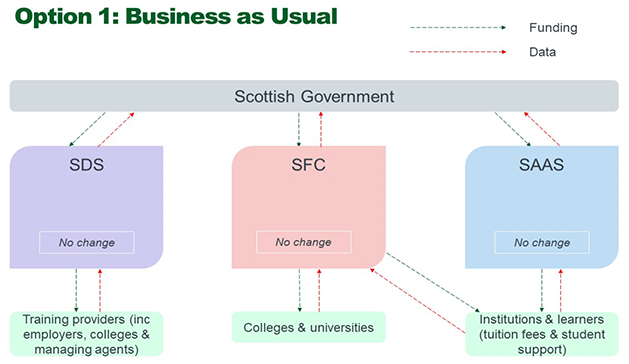
Delivery of post-school education and skills funding would continue to be delivered through three bodies (SFC, SAAS and SDS).
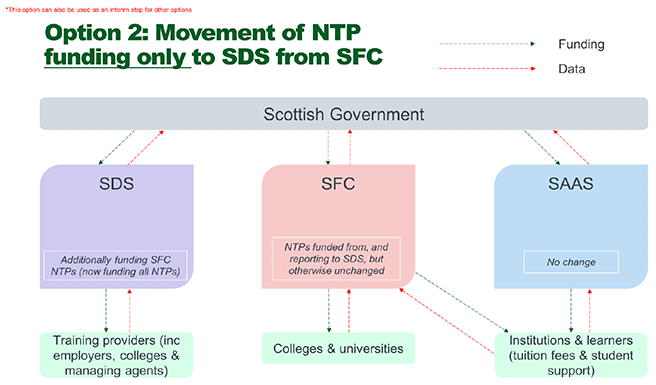
This option would allow all national training programme funding to be distributed by one public body (SDS) which would allow some flexibility across different apprenticeship schemes. The core funding, routed through the credit model that SFC currently uses to fund GA’s, some elements of MA’s and FA’s would be redirected to SDS for SDS to allocate across the apprenticeship schemes. This would allow all data on apprenticeships to flow to the Scottish Government from one organisation, however provision would still be split across SDS and SFC. Research funding would still sit within SFC and there would be no change to student support funding which would still be split across SFC and SAAS.
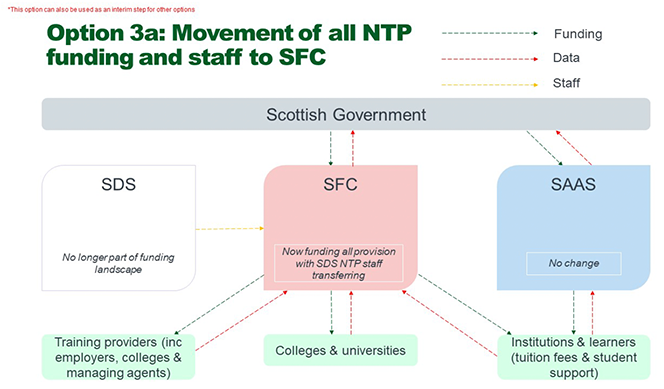
This option would see all national training programmes and provision funded by a single body (SFC) with staff and funding moving across from SDS to support this change. SFC would most likely need to change systems to collect data from, and pay, apprenticeship providers. This could include transferring the data systems currently in place at SDS although this would need investigated further with technical working groups at the outline business case stage. This option would also require legislation to broaden the range of providers that the SFC is able to fund to deliver fundable further and higher education. While subordinate legislation could be used to make some additions to the bodies the SFC can fund, in order to deliver a system that would be workable in practical terms, it is considered that some changes to primary legislation, around the functions of the SFC, would be required. In this option research funding remains with the SFC and there is no change to student support with this being funded by SAAS and SFC.
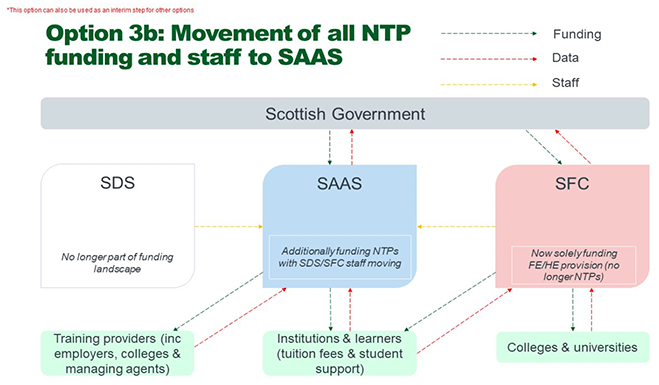
This option would see all national training programmes funded by SAAS in addition to their existing student support offer. To facilitate this, staff and funding would need to move from both SDS and SFC. SAAS would also need to adapt existing systems to facilitate the change or transfer systems from the other bodies. Again, this would need investigated further with technical groups at the outline business case stage. SFC would continue to fund FE/HE provision and research. Funding of provision would continue to be split between SAAS and SFC in this option and there would be no change to student support funding which would remain split between SAAS and SFC.
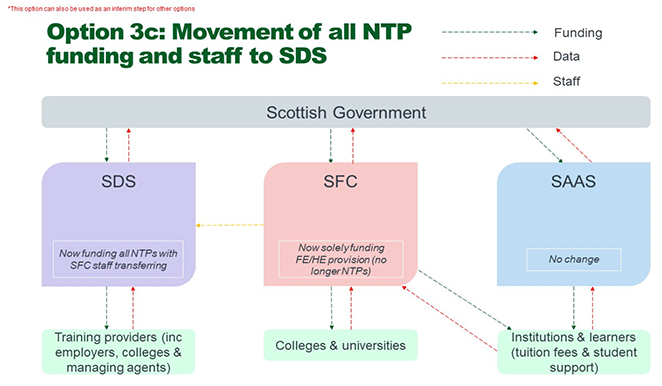
This option is similar to Option 2 but would additionally involve any functional groupings of staff within the SFC being transferred to SDS to work on national training programmes, including modern, graduate and foundation apprenticeships. The identification of NTP funds within SFC would be challenging as, in recent years, FA and GA provision delivered through SFC has been drawn down in credits as part of core funding. The detail of how to identify and transfer any funds in this option would have to be worked through by technical working groups if it were taken forward to outline business case. It is unlikely that any system changes would be required to facilitate this option as SDS either currently or has previously delivered all of these programmes.
Option 3c would slightly simplify the system by having one body responsible for funding all national training programmes. However, funding of provision would continue to be split between SDS and SFC in this option. Research would remain with SFC and student support would continue to be split between SAAS and SFC.
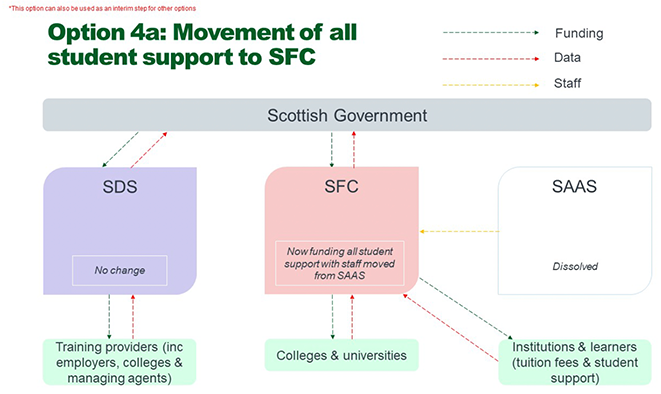
This option would simplify the system by seeing all student support for HE and FE being funded by one body (SFC). To facilitate this change, staff and funding from SAAS would need to transfer to SFC likely resulting in the dissolution of SAAS. It is likely that new systems will be required at SFC to perform these new functions or systems transferred from SAAS. This detail would need to be worked through by technical working groups at outline business case stage. Funding of provision would continue to be split between SDS and SFC in this option. Research would remain with SFC.
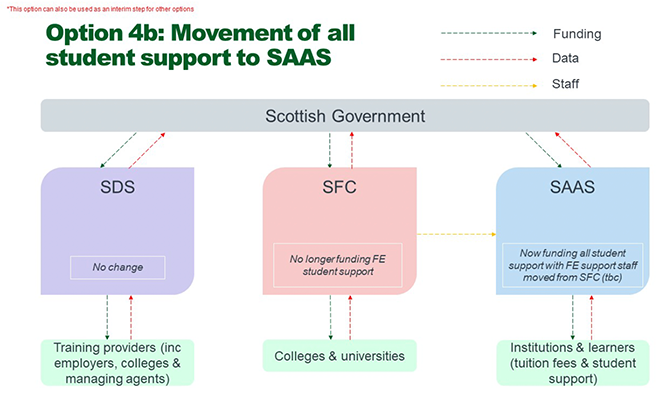
This option would also allow all student support for FE and HE to be administered by one body (SAAS). This would require funding being transferred from SFC and operational responsibility for determining how FE student support funding is administered would pass to SAAS. It is unclear at this stage whether the staff currently administering FE student support in SFC would move alongside the funding.
This would have to be explored with technical groups if this option is shortlisted for further development at outline business case stage. Funding of provision would continue to be split between SDS and SFC in this option. Research would remain with SFC.
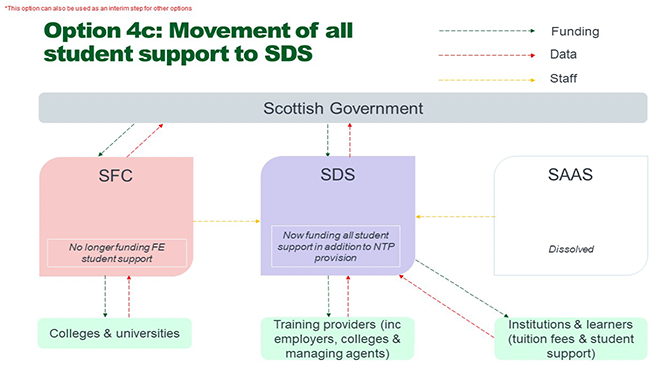
This option would also allow all student support for FE and HE to be administered by one body (SDS). This would require funding and staff being transferred from SAAS and SFC to SDS to facilitate this change. Due to the current lack of SDS involvement in the student support system, a significant amount of detail related to systems and processes would need to be worked through with technical groups at outline business case if this option were to progress. Funding of provision would continue to be split between SDS and SFC in this option. Research would remain with SFC.
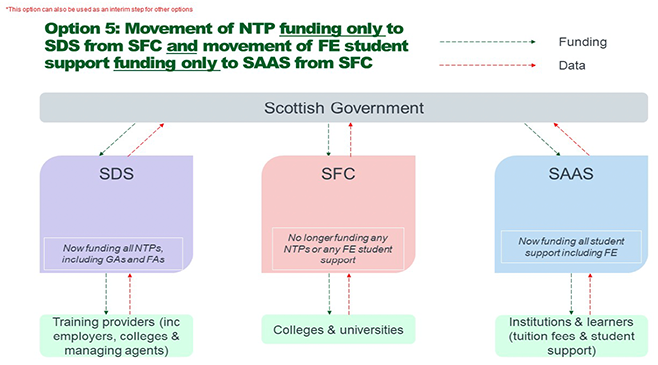
This option combines two moves of solely funding, one for national training programmes from SFC to SDS (Option 2) and one for FE student support moving from SFC to SAAS (Option 4b). These moves were considered the only options where the movement of solely funding may be feasible without the movement of staff and systems.
However, the feasibility of this option would need to be considered further by technical groups at outline business case stage as SDS and SAAS may not be able to administer additional funding within their existing resource.
This option would slightly simplify the landscape by reducing areas where more than one body carries out the function, however would still see provision split between two bodies (SFC and SDS).
In addition, the identification of NTP funds within SFC would be challenging as, in recent years, FA and GA provision delivered through SFC has been drawn down in credits as part of core funding. The detail of how to identify and transfer any funds in this option would have to be worked through in detail by technical working groups if it were taken forward to outline business case. Research would remain with SFC.
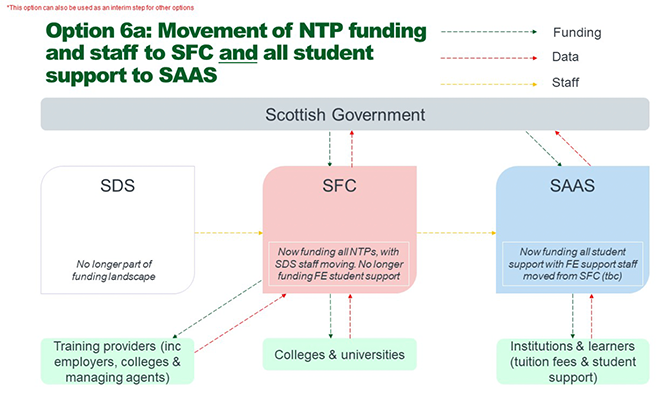
This option would allow for all provision to be funded by one body (SFC) and all student support to be funded by one body (SAAS).
For provision, national training programme staff and funding would be transferred from SDS to SFC to enable SFC to have full operational responsibility for all types of provision.
For student support, SFC would transfer responsibility for administering FE student support funding to SAAS.
As per Option 4b it is not clear whether SFC staff currently working on this support would transfer to SAAS to support this change. Details of staffing and system changes would need to be worked through with technical groups at outline business case. Research would remain with SFC.
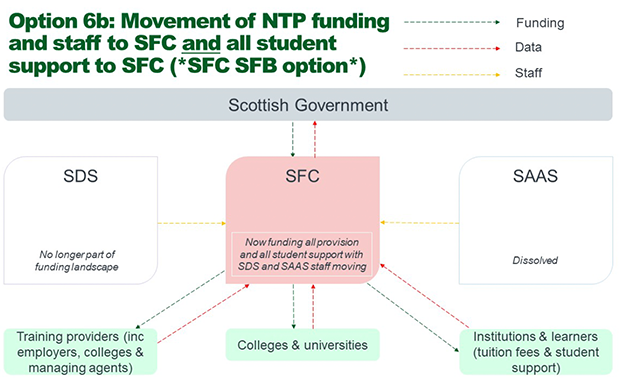
This option would see all provision and all student support funded by a single body (SFC).
Regarding provision, national training programmes funding and staff would be transferred from SDS to SFC to give SFC full operational responsibility over all aspects of provision.
SFC would assume full responsibility for all FE and HE student support with staff and funding moving from SAAS to support this change. This would result in the dissolution of SAAS. Details of staffing and system changes would need to be worked through with technical groups at outline business case. Research would remain with SFC.
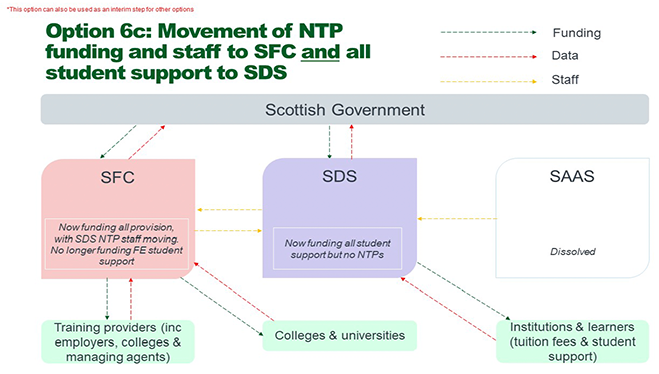
This option would also result in one body responsible for funding all provision (SFC) and one body responsible for funding all student support (SDS).
This scenario would result in SDS losing responsibility for funding national training programmes with staff and systems transferring to SFC, but gaining responsibility for all student support with staff, systems and funding transferring from both SAAS and SFC.
This scenario involves significant changes to existing responsibilities and therefore a number of details related to staffing and systems would need to be worked through with technical groups at outline business case stage. Research would remain with SFC.
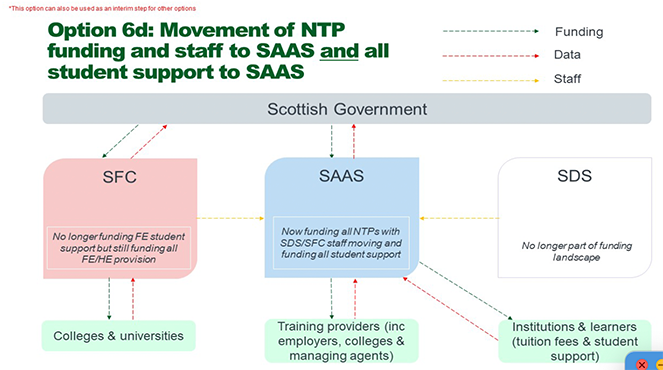
This option would see all student support funded by a single body (SAAS) with FE student support moving across from SFC.
SAAS would also gain responsibility for national training programmes with SFC and SDS staff, systems and funding transferring.
SFC would retain responsibility for funding HE and FE provision. SDS would no longer be part of the funding landscape in this scenario. The funding of provision would still be split between two bodies in this option. Details of staffing and system changes would need to be worked through with technical groups at outline business case. Research would remain with SFC.
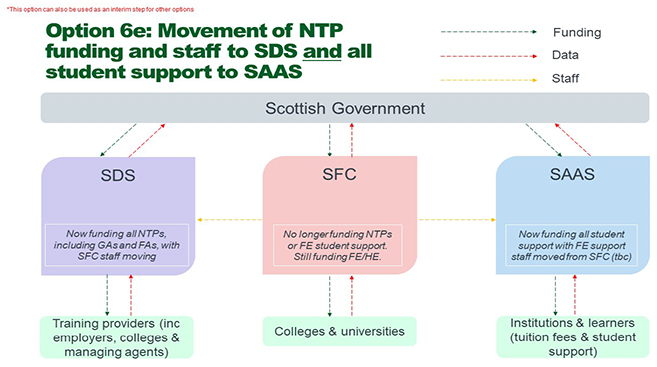
This option would involve clarifying roles within the landscape, with SDS assuming full operational responsibility over national training programmes with SFC NTP funding and any identifiable groupings of staff transferring across.
The identification of NTP funds within SFC would be challenging as, in recent years, FA and GA provision delivered through SFC has been drawn down in credits as part of core funding.
Student support would be consolidated within SAAS with SFC FE student support function transferring across.
In this option, provision would continue to be split across two bodies (SFC and SDS). Details of staffing and system changes would need to be worked through with technical groups at outline business case. Research would remain with SFC.
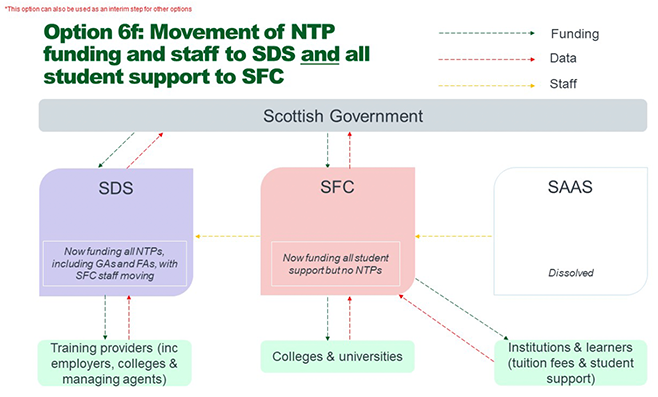
This option would see SFC responsible for all student support, with SAAS funding, systems and staff transferring across the facilitate this change.
SDS would gain operational responsibility for all national training programmes with SFC staff and funding transferring across. The identification of NTP funds within SFC would be challenging as, in recent years, FA and GA provision delivered through SFC has been drawn down in credits as part of core funding.
SAAS would be dissolved in this scenario.
Provision would still be split across two bodies in this scenario. Details of staffing and system changes would need to be worked through with technical groups at outline business case. Research would remain with SFC.
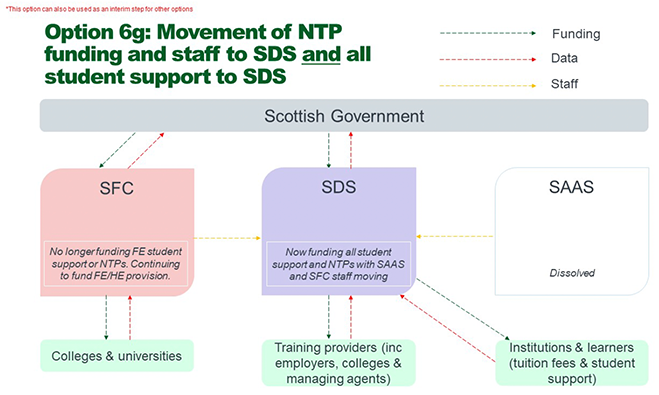
This option would also see SDS gain operational responsibility for all national training programmes but additionally, SDS would gain responsibility for all student support, with staff, systems and funding moving from SAAS and SFC.
SAAS would be dissolved in this scenario.
Again, provision would still be split between SFC and SDS in this scenario. The identification of NTP funds within SFC would be challenging as, in recent years, FA and GA provision delivered through SFC has been drawn down in credits as part of core funding.
Details of staffing and system changes would need to be worked through with technical groups at outline business case. Research would remain with SFC.
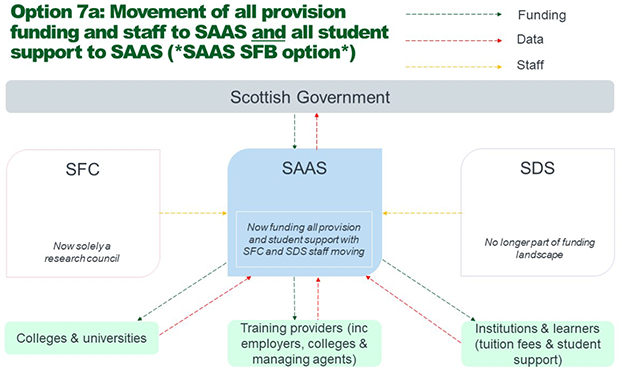
This option would see all provision and student support funded by a single body (SAAS).
Staff and funding for all FE/HE provision, national training programmes and FE student support in SFC would be transferred to SAAS. Staff and funding for national training programmes within SDS would transfer to SAAS.
SDS would no longer be part of the funding landscape in this scenario and SFC would likely be left as solely a research council.
This scenario involves significant changes to existing responsibilities and therefore a number of details related to legislation, staffing and systems would need to be worked through with technical groups at outline business case stage.
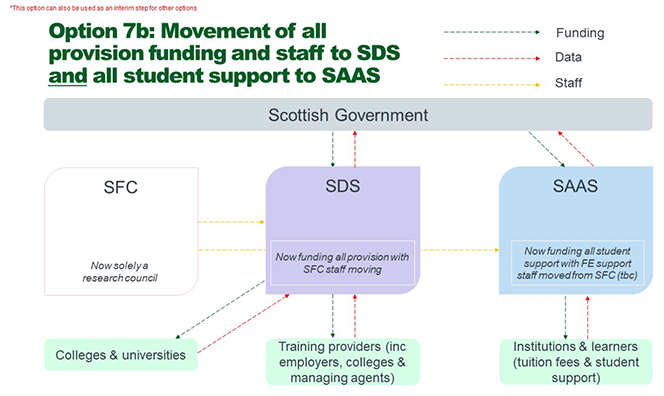
This option would see all provision being consolidated in one body (SDS) and all student support consolidated in another body (SAAS).
Funding and staff related to FE/HE provision and national training programmes in SFC would transfer across to SDS to facilitate this change.
Funding and any functional grouping of staff related to FE student support would transfer across to SAAS.
This scenario would leave SFC operating as solely a research council.
Details of staffing and system changes as well as legislation would need to be worked through with technical groups at outline business case.
Option 7c – Movement of all provision and staff from SFC to SDS and all student support funding delivered through SDS - e.g. a single funding body built on SDS systems and structures.
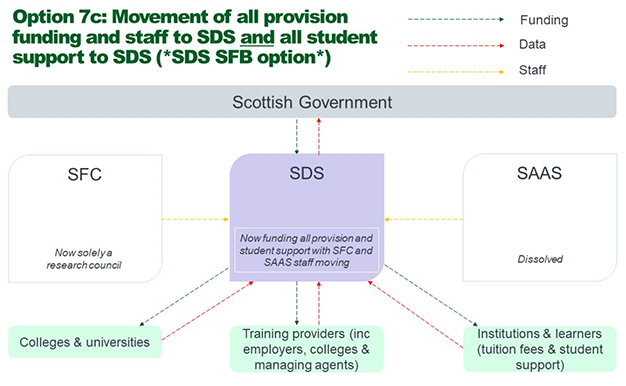
This option would see all provision and student support funded by a single body (SDS).
Staff, systems and funding for all FE/HE provision, national training programmes and FE student support in SFC would be transferred to SDS.
Staff, systems and funding for all existing student support within SAAS would also transfer to SDS.
SAAS would be dissolved in this scenario and SFC would likely be left as solely a research council.
This scenario involves significant changes to existing responsibilities and therefore a number of details related to staffing, systems and legislation would need to be worked through with technical groups at outline business case stage.
Options assessment criterion
The purpose of long-list appraisal is to narrow down possible options to identify an optimum short-list of viable options for detailed appraisal in the next stage of the business case, the Outline Business Case, that meet the requirement of delivering the spending objectives, and satisfy the critical success factors (CSFs) as seen in table below.
As per the HMT Green Book Guidance, options in the long-list are to be discounted if they fail to deliver the spending objectives and CSFs for the project; appear unlikely to deliver sufficient benefits, considering the intention is to deliver Value for Money; are clearly unpractical/unfeasible; or an option is clearly inferior to another, because it has greater costs and lower benefits; if they violate constraints, such as are clearly unaffordable or too risky; or if options are sufficiently similar to allow a single representative option to be selected for detailed analysis.
SG policy officials and analysts collectively assessed all long-list options against the criteria set out in a workshop. Each option was rated as “red”, “amber”, or “green”, expressing the delivery structure not satisfying, partially satisfying, or fully satisfying the appropriate appraisal criteria. During the assessment further consideration of constraints, dependencies, unmonetised and unquantifiable factors, and possible collateral effects as well as unintended consequences was taken based on currently available evidence.
Legal Considerations
In development and consideration of the long list of options, legal considerations, primarily focussed on legislative requirements to facilitate delivery of the options, were explored with SGLD colleagues. These considerations were scored as part of the Critical Success Factor 5 - Potential achievability. Other factors contributing to CSF 5 include resourcing constraints.
A further consideration was the risk of ONS reclassification that could result if changes to the post-school funding body landscape are deemed to enhance the degree of control that Ministers have on universities.
While any option could technically be achieved through changes to primary legislation, not all are advisable. Therefore, it was agreed that any option that had been deemed inadvisable based on initial legal advice[46] was rated red; options that would require changes to primary legislation in order to be achievable but were advised to be feasible following initial legal advice, were rated amber; and options that would not require any changes to primary legislation and were practicable to pursue were rated green.
Critical Success Factors |
||
Ref |
Critical Success Factor |
Description |
1 |
Strategic fit and meeting business needs |
How well the option meets the agreed spending objectives, related business needs and service requirements, how well the option provides holistic fit and synergy with other strategies. |
In the context of this SOC, this means
the option results in a more agile and responsive system that is accountable, trusted to deliver and subject to effective governance. |
||
2 |
Potential Value for Money |
How well the option optimises social value (social, economic and environmental), in terms of the potential costs, benefits and risks. |
In the context of this SOC, this means how well the option
|
||
3 |
Supplier capacity and capability, operational fit |
How well the option matches the ability of potential suppliers to deliver the required services and appeals to the supply side. |
In the context of this SOC, this means how well the option
|
||
4 |
Potential affordability |
How well the option can be financed from available funds, balance of investment against the improved outcomes aligns with sourcing constraints. |
In the context of this SOC, this means
|
||
5 |
Potential achievability |
How well the option is likely to be delivered given an organisation's ability to respond to the changes required, how well the option matches the level of available skills required for successful delivery? |
In the context of this SOC, this means
|
||
Long-list Options Assessment
The outcome of the long-list assessment workshops is presented in Table 8 above. Reasons for rejecting, selecting, or carrying forward options are summarised below.
As set out in section 3.3.1, the long-list options are categorised into four groups:
1. Options that solely move funding and/or delivery of provision,
2. Options that solely move funding and/or delivery of student support,
3. Options that move funding and/or delivery of both provision and student support, and
4. Options that create an entirely new single funding body.
Options that solely move funding and/or delivery of provision
None of the options solely suggesting the move of funding and/or delivery of provision fully meet the spending objectives or the strategic ambitions of the programme.
Options 2 and 3c proposed either the move of funding or funding, systems and staff (i.e. delivery) of all NTP funding to SDS.
Option 2 is unlikely to bring any meaningful change to system, as it relates only to money being administered through a different route, with no changes to delivery.
Option 3c would see some simplification of the funding landscape for apprenticeships and other National Training Programme funding and delivery (due to both funding and staff moves), including potential improvements in data alignment. However, the value for money case is unclear for these options and they also fail to address wider complexities of the funding landscape for provision. Furthermore, both Options 2 and 3c propose giving more responsibility to an organisation without legislative underpinning. This raises concerns about transparency, accountability to government, and ensuring good value for public money. While a legal basis could in theory be created, it would be time-consuming and expensive.
The movement of NTP funding and staff to SAAS in Option 3b similarly fails to address the fragmentation of funding landscape for provision, leaving Further and Higher Education (FE and HE) funding with SFC and bringing NTP funding into a body that has no prior structures or experience in place for managing training provision funding.
Finally, of all the options in this category, Option 3a best meets all of the objectives and strategic ambitions for the project from the perspective of provision. With the move of NTP funding to SFC, this option would bring together funding, development and delivery of all provision (colleges, universities and training provision), enabling improved availability and quality of data and therefore a better understanding of how the funding is currently distributed, allowing for more informed, transparent and equitable distribution of funding for provision to be developed. This option is likely to lead to efficiencies and would be expected to bring value for money. Additionally, while it requires primary legislation to give the SFC these new responsibilities, this would be more straightforward than setting up a new statutory body, given that SFC has existing statutory functions that can be built on. However, this option fails to address the fragmentation of the funding landscape for student support – a core requirement identified in the scope of this project.
Options that solely move funding and/or delivery of student support
Each of the options considered in this category would bring student support under one body, in theory satisfying the spending objectives for the project from the perspective of student support, with having both FE and HE student support together allowing for improved quality of data and enabling more targeted and equitable distribution of funds to learners across the sector. However, the options differ particularly in respect to value for money as well as legal considerations.
Options 4a and 4c propose the move of Higher Education funding away from SAAS to either SFC or SDS, neither of which currently have the structures or experience in distributing funding to learners at this scale. This means that putting these structures in place and moving the associated staff from SAAS is likely to be very costly for these two scenarios, making the value for money case uncertain. Furthermore, similarly to Options 2 and 3c, the movement of student support funding to SDS in Option 4c would be inadvisable due to SDS not having statutory underpinning (for reasons described in options above). For Option 4a, movement of student support funding to SFC would require changes to primary legislation to expand its functions.
Option 4b, on the other hand, proposes the move of FE student support funding functions to SAAS, who have the ability to incorporate this into their existing systems more easily. In addition to the benefits highlighted above on bringing student support under one organisation, this option would require at most very minimal staff moves, therefore making the move cost-effective and would not require changes to primary legislation and therefore would be achievable. However, while Option 4b would likely bring value for money it still fails to address the issues around fragmentation of funding for provision, as do all of the options in this category.
Options that move funding and/or delivery of both provision and student support
Options in this category are different combinations of the options in the two previous categories.
For example, Option 5 is a combination of Options 2 and 4b, and therefore, despite delivering on the ambitions for student support (see Option 4b), it still fundamentally fails to deliver any meaningful simplification to the operational responsibility across provision funding landscape.
Similarly, Options 6e, 6f and 6g all duplicate Option 3c failing to deliver strategic ambitions on the funding body landscape for provision. The difference between these options is how student support is delivered (through either SAAS, SFC or SDS), with Option 6e, looking at transfer of FE support from SFC to SAAS the only one expected to deliver value for money and strategic ambitions for student support (see Option 4b).
Option 6d, on the other hand, combines Options 3b and 4b, again failing to address the fragmentation of funding for provision.
Two Options (6a and 6c) in this category suggest the movement of all provision under one body and all student support under another, which, in theory would satisfy the simplification of the funding body landscape across the sector, improve data collection and quality, bring efficiencies and enable more equitable and transparent distribution of funding for learners. However, not all combinations of these options are optimal or advisable in practice.
For example, Option 6c which would bring all funding for provision under SFC and all student support funding under SDS is not considered viable as, while it addresses the fragmentation in both provision and student support space, the movement of student support to SDS is not advisable since SDS has no statutory underpinning (for the reasons described in earlier sections), with this movement of funding also unlikely to bring value for money.
Option 6a, on the other hand, is assessed to fulfil criteria for the totality of the core scope of this project, deliver long-term efficiencies and value for money. In this option the post-school funding landscape is simplified by bringing all provision to SFC and all student support to SAAS, meeting the objectives and majority of the critical success factors of this project.
Options 6b, 7a and 7c all propose a single funding body built on SFC, SAAS and SDS systems and structures respectively. All of these options in theory meet the criteria for simplifying operational responsibility, however significant risks lie in moving functions to a body without previous experience of administering funds across the whole of the institutional landscape.
Building a single funding body on SAAS structures and systems has possible implications for the independent status of HE institutions as it would bring their funding into the more direct control of Ministers. Building a single funding body on SDS structures requires revoking the existing statutory framework underpinning of SFC in the delivery of FE and HE provision to move it to SDS – an organisation that does not currently have a statutory foundation. A single body to be built from SFC would also require further work to develop an understanding of underpinning costs but the legislative underpinning and NDPB status makes this a preferrable body on which to build a single funding body from. The value for money case is not certain for these options, as it is unclear whether bringing student support and provision under one body is necessary, rather than having two bodies, one for student support and one for provision. This would require further investigation.
Options that create an entirely new Single Funding Body
Option 8 proposes an entirely new single funding body. Whilst it would meet the objectives of this project by delivering all functions through one body, it would likely be more complex and costly to deliver than similar Options 6b, 7a and 7c, as it would require winding down existing bodies. And notably this option would also go against the Scottish Government’s guidance on the establishment of new public bodies which states that new public bodies should only be established as a last resort. All other available options have to be considered first, in particular where there are existing public bodies in the landscape with broadly similar functions.
Arrival at a short-list
After the dissemination and evaluation of the findings from the long-list assessment workshops, a separate workshop was held to agree on the short-list to be taken forward to the Outline Business Case stage.
As per the HMT Green Book Guidance, all shortlisted options must be viable and meet the requirement of delivering the objectives. The shortlist must include Business as Usual, a realistic and achievable ‘do minimum’ that meets essential requirements, the preferred way forward if different to ‘do minimum’, and any other options that have been carried forward.
The short-list options carried forward for detailed appraisal are presented in the table below.
Short-list of options carried forward to OBC for detailed appraisal
Business as usual |
1. Business as usual |
Preferred way forward; Do minimum |
6a. Movement of NTP funding and staff to SFC and all student support funding delivered through SAAS. |
More ambitious |
6b. Movement of NTP funding and staff to SFC and all student support funding delivered through SFC. |
Based on the discussion in Section 3.3.3, options besides BAU which sufficiently satisfy the assessment criteria are 6a, assessed as the preferred way forward and 6b, assessed as the more ambitious way forward.
Although several of the options, including 3a, 4b, 6c, 6d, 6e, 7a, 7b, 7c and 8, at least partially meet the objectives and strategic ambitions for the project, they either do not fulfil the totality of the core scope of the project, leaving the landscape fragmented and/or are unadvisable from legal and value for money perspectives. The short-listed options, however, are sufficiently similar to these options by either combining some of these options or offering a similar solution, but with stronger value for money and/or legal arguments and a more holistic approach to addressing the core scope requirements.
Contact
Email: postschoolreform@gov.scot
There is a problem
Thanks for your feedback